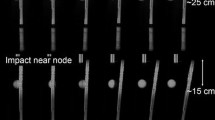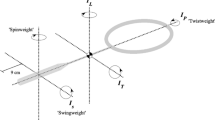Abstract
In this paper, we describe an experimental investigation of the oblique impact between a tennis ball and head clamped tennis racket. It was found that the magnitude of the ball rebound spin was not a function of the material, gage or tension of the string used in the tennis racket. Furthermore, it was concluded that all strings exhibit a sufficiently large friction coefficient that the ball begins to roll during impact. There is anecdotal evidence from tennis players that suggests that a high string tension or a rough string surface enable them to impart more spin to the ball. For example, players have been quoted as saying that a high string tension makes the strings “bite” into the ball, giving more spin. The data reported in this study do not support these observations. Analysis of the experimental data has shown that the balls are rebounding from the surface with more spin than would typically be associated with rolling. A second experiment showed that the balls commenced rolling at the mid-point of the impact. This information was used in a theoretical model to show that the spin that acts on the ball during the impact can be higher than the value of the rolling spin at the end of the impact.
Similar content being viewed by others
Abbreviations
- A K :
-
ball compression factor
- F :
-
friction force
- R :
-
reaction force
- r B :
-
radius of undeformed ball (=32 mm)
- r (t) :
-
radius of ball (at time=t)
- r (MID) :
-
radius of ball (at the mid-point of impact)
- t :
-
time
- T C :
-
contact time
- U x(f) :
-
stringbed velocity parallel to string plane (at the end of the impact)
- V B(i) :
-
inbound ball velocity
- V B(f) :
-
rebound ball velocity
- V x(i) :
-
inbound ball velocity parallel to string plane
- V y(i) :
-
inbound ball velocity normal to string plane
- V y(f) :
-
rebound ball velocity normal to string plane
- V x(f) :
-
rebound ball velocity parallel to string plane
- V x(t) :
-
ball velocity parallel to string plane (at time=t)
- V y(t) :
-
ball velocity normal to string plane (at time=t)
- V x(MID) :
-
ball velocity parallel to string plane (at the midpoint of the impact)
- ω (i) :
-
inbound ball spin
- ω (f) :
-
rebound ball spin
- ω (MID) :
-
ball spin (at the mid-point of impact)
- ω (ROLL) :
-
rolling spin (ball leaving surface)
- μ S :
-
coefficient of sliding friction
- θ B(i) :
-
inbound angle of trajectory
- θ B(f) :
-
rebound angle of trajectory
References
Fischer, W., “Tennis Racket,” US Patent 4,273,331 (1977).
Cross, R., “Dynamic Properties of Tennis Strings,”Tennis, Science and Technology, London, Blackwell Science, Oxford, 119–126 (2000).
Ashcroft, A. andStronge, W.J., “Putting Spin on a Tennis Ball: Friction Between Tennis Ball and Racket String-bed,”The Engineering of Sport, Kyoto, Blackwell Science, Oxford (2002).
Putnam, C.A. andBaker, J.A.W., “Spin Imparted to a Tennis Ball During Impact With Conventionally and Diagonally Strung Rackets,”Research Quarterly for Exercise and Sport,55, (3),261–265 (1984).
UC Davis, http://wings.avkids.com/Tennis/Project/motion-02.html (2002).
Cross, R., “Effects of Friction Between the Ball and Strings in Tennis,”Sports Engineering,3 (2),85–97 (2000).
Brody, H., “That's How the Ball Bounces,” The Physics Teacher, 494–497 (1984).
Cross, R., “Measurements of the Horizontal Coefficient of Restitution for a Superball and a Tennis Ball,”American Journal of Physics,70 (5),482–489 (2002).
Cross, R., “Grip-slip Behavior of a Bouncing Ball,”American Journal of Physics,70 (11),1093–1102 (2002).
Gobush, B., “Spin and the Inner Workings of a Golf Ball,”Golf—The Scientific Way, Aston Publishing Group, Hemel Hempstead, UK, 141–145 (1995).
Goodwill, S.R., “Dynamic Comparison of Tennis ball Impacts on an Artificial Surface,” B. Eng Thesis, University of Sheffield (1997).
Brody, H., “A Limit on Spin,” International Tennis Federation Technical Commission meeting, Brussels (2000).
Goodwill, S.R., “The Dynamics of Tennis Ball Impacts on Tennis Rackets”, Ph.D. Thesis, University of Sheffield (2002).
Goodwill, S.R. andHaake, S.J., “Why Were Spaghetti String Rackets Banned in the Game of Tennis?”The Engineering of Sport, Kyoto, Blackwell Science, Oxford (2002).
International Tennis Federation, “Rules of Tennis,”Wilton, Wright & Son, London (2000).




